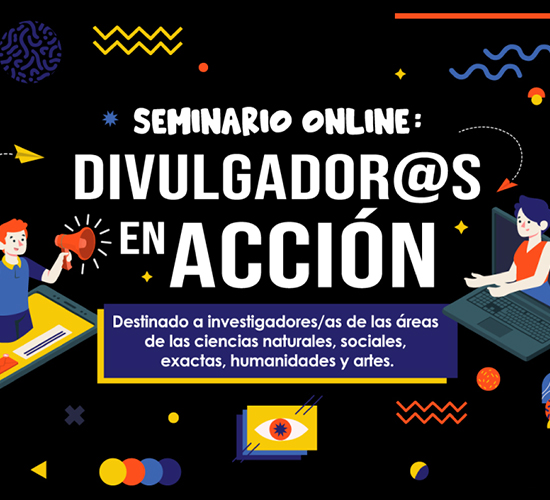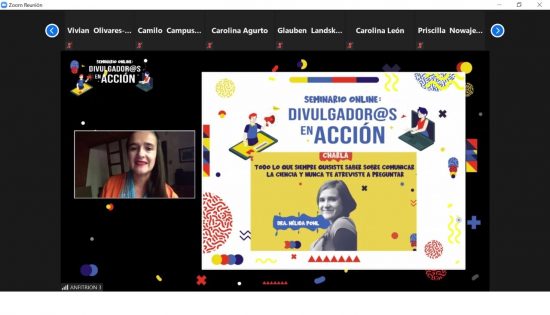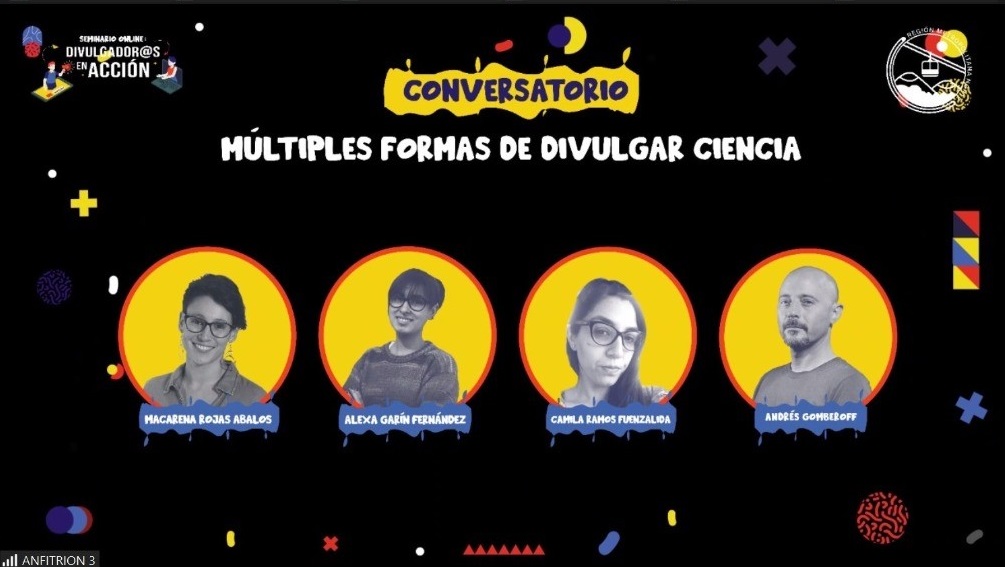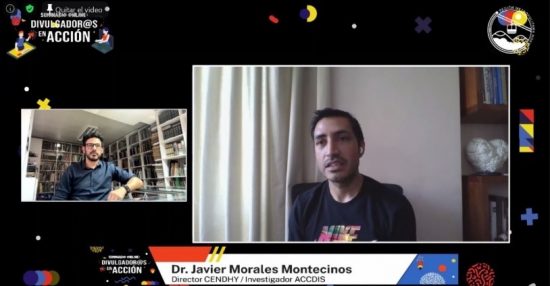Communicating science in the midst of a pandemic

In this global scenario where a biological agent puts our immune system in check, scientist, doctors and doctors have become part of the usual programming in the media, writing letters, giving interviews or making threads on Twitter. They are experts in science or in doing science classes, but they are not experts in communicating science to an audience other than their peers.
This lack of tools, methodologies and skills for communicating science, is precisely what was addressed in the webinar "Divulgador@s in Action" on Tuesday, January 26 at 2 p.m.:00 and 17:30 hours. An event organized by the Regional Partnership Project Northern Metropolitan Region, Ministry of Science, Technology, Knowledge and innovation, led by the University of Chile through the Faculty of Chemical and Pharmaceutical Sciences, and its executing unit, the Center for advanced chronic diseases (ACCDiS ) who next to the Center for New Drugs for Hypertension (CENDHY) handed over to the researchers, students and teachers tools to communicate science effectively and showed diversity of formats for scientific dissemination.
Starting with the proclamation of the World Health Organization, held in 1948 declaring it "the right to enjoy the benefits of scientific progress and its applications" as part of the International Covenant on Economic Rights, Social and Cultural. It establishes the guarantee of all people's access to scientific information and the opportunity to contribute to science research, empowering communities in decision-making. To comply with this right, the participation of researchers in the transmission of knowledge is essential as, as protagonists of scientific development and as generators of new knowledge, are the most reliable source.
In this sense, the director of Explora RM North, Dr. Mario Chiong, said the task of communicating science outside the academic sphere, to help foster culture and build a fairer society, it's a moral duty of scientists and scientists."We are morally obliged to be spreaders and spreaders of science, and it is our duty not only to properly communicate knowledge to the community, but also help in scientific literacy”, commented the academic of the University of Chile and acceding researcher ACCDiS.
Spaces and instances to communicate science
Among the questions that most pointed out the attendees during the day, were: "Where do you start to divulge? What should I do first?”. In the face of these concerns, Dr. Chiong explained that a good opportunity to start are talks in schools, visiting schoolchildren in their laboratories or giving an interview to a media outlet, He also added that the Explora program has the "Open Science" initiative through which researchers are invited to give talks for non-scientific audiences and "School Scientific Research" in which researchers can be tutors of school research clubs.
The Director of par RM Norte also noted that other ways of disclosing science, it's through capsules, Podcast, opinion columns, Infographics, art and science initiatives, What "allow you to explore different formats depending on the skills each naturally has".
Dr.. Nélida Pohl
True to his energetic style, relaxed and close, the Director of Communications at the Institute of Ecology and Biodiversity (Ieb) and president of the Chilean Association of Journalists and Professionals for the Communication of Science (ACHIPEC), DRA. Nélida Pohl, gave attendees the inaugural talk "Everything you've ever wanted to know about communicating science and never dared to ask".
 In his presentation, the academic coordinator of the Graduate Diploma in Science Communication at the Faculty of Sciences of the University of Chile, was in favour of "everyone who is interested in being part of the interface between science and society must make communication from science" and they can do it through "all the formats imaginable through which people are not only educated and informed, but also entertains or devotes his free time", said.
In his presentation, the academic coordinator of the Graduate Diploma in Science Communication at the Faculty of Sciences of the University of Chile, was in favour of "everyone who is interested in being part of the interface between science and society must make communication from science" and they can do it through "all the formats imaginable through which people are not only educated and informed, but also entertains or devotes his free time", said.
In science outreach, as expressed by Dr.. Pohl, scientists are the primary source of information and the first link in the communication chain, but "it is not enough to make available all the knowledge one has and fulfill a small role as just an information impartor, because that doesn't mean that all people are going to have equal access to that information". For this reason, indicated that alternatives needed to be offered and dialogue encouraged.
Understanding that there is a multiplicity of reasons why people who do science decide to participate in science communication activities, the academic listed some little-known advantages that she has managed to identify in her years of experience and which are supported by international studies, such as that it is associated with a higher h-index, facilitating the writing of scientific articles and projects for insolvency funds, and that gives greater visibility to research.
In a more practical aspect, the Dra. Pohl recommended communicating that science is a process whose protagonists are human people, use narrative tools to tell the stories of scientific findings and remember what he called "the golden triad". First, define the audience to which the activity is directed and be clear that there is no "general public". Second, define the most appropriate format for that audience. And third, set a clear goal on what is to be achieved.
Multiple ways to spread science
It was the conversational conversation where Dr.. Alexa Garín-Fernández; the researcher at the Center for Scientific Studies (Cec) and author of outreach books, Dr. Andrés Gomberoff; the Director of the Strategic Linking Department of the Vice-Chancellor of Media Linkage at the University of Santiago de Chile and Director of Cambalache Magazine, Camila Ramos Fuenzalida; and the biologist with Master in Journalism at the Catholic University, UC Communications Faculty teacher and driver at TXS Radio, Macarena Rojas Abalos.
 As Dr.. Nélida Pohl in her inaugural talk, the motivations for communicating science are varied. Being consulted about your decision, Macarena Rojas, who is also Executive Director of the Geroscience Center, Mental Health and metabolism (GERO), consigned that it was difficult for her to put aside her academic career and take a "leap into the void" to devote herself entirely to scientific communication, but was motivated by "the lack of scientific information that I saw in me, in my friends, in my generation, in my lab". He concluded that "even though it has cost, right now I think I took the right course".
As Dr.. Nélida Pohl in her inaugural talk, the motivations for communicating science are varied. Being consulted about your decision, Macarena Rojas, who is also Executive Director of the Geroscience Center, Mental Health and metabolism (GERO), consigned that it was difficult for her to put aside her academic career and take a "leap into the void" to devote herself entirely to scientific communication, but was motivated by "the lack of scientific information that I saw in me, in my friends, in my generation, in my lab". He concluded that "even though it has cost, right now I think I took the right course".
On the other hand, doctor of Physics and recurring contributor in the columns of the Trends section of The Third, Andrés Gomberoff, told him that he started amateurly, but that science communication is an activity in which he has been professionalized and that he prefers to call "non-scientific fiction". In this sense, commented that since his work at the CEC he is in a kind of "struggle" to open these spaces as he believes that "this we call science outreach is a natural part of the academy and must be integrated into the academy".
PhD in microbiology Alexa Garín-Fernández, who contacted from Germany where she was a scholarship to perform her PhD, told the audience about her beginnings at Antofagasta as a degree in biotechnology and her ongoing relationship with art as a form of expression. "I could explain many concepts through drawings or diagrams, and I was able to make that compatible in the PhD to talk about concepts as abstract as microorganisms, then that opened the door for outreach events open to the community", explained the illustrator.
When consulted on the evolution of Cambalache and its adaptation to different formats and audiences, Camila Ramos said that it all started with a survey of USACH academics conducted in 2016 about facilitators to link with the environment, which revealed that there was a willingness to participate in outreach activities, but that there was a lack of instances to do so. As a result of these results, as Camila explained, vice-chancellor generated this space in the form of a Knowledge Festival, the first version of Cambalache.
As to how their science communication and outreach activities have been affected by the pandemic, Andrew believes that the writing of columns and books of "scientific nonfiction" were not altered, but the situation certainly doesn't allow you to talk to other people and exchange ideas like they did before. Alexa added that, where appropriate, as a comic book illustrator on microbiology, turned more to social media and found in this adverse scenario an opportunity to focus on Chile's social context. On the same line, Camila stated that the pandemic reinforced its convictions that it was necessary to increase the instances of knowledge communication and linkage with the environment, because "the pandemic showed us that economic gaps widened, social, technological and educational, and those of us in educational institutions have a citizen responsibility". In what was perhaps the most extreme case, Camila commented that the pandemic prevented them from holding a large Cambalache festival in the summer of 2020 and the itinerant festivals, and forced them to launch three issues of the magazine instead of one as planned. As a teacher, Macarena had to adapt to doing virtual lessons, while about his experience on radio, told him that "we've filled ourselves with podcasts, but what we do on TXS Radio is see which of those podcasts are listened to by those who are not friends or family".
Disclosure of science for structured minds
To end a marathon day, the scientific popularizer and president of Fundación 42, José Ilic Garcia, dictated the workshop "How to do a scientific outreach talk?”.
The scientific community has in common that its trade is governed by the scientific method, which is an ordered sequence of steps in which a hypothesis is constructed and its veracity verified through experimentation. It's a systematic process, structured and rational that may seem a little arid to people who don't engage in science, but for the researchers, that organization is all they know. As the "magician Ilic" revealed in his workshop, which is the product of his research in his Master thesis, the structure of a scientific outreach talk is very different from writing an academic paper or giving a class at the university.
In correspondence with dr.. Nélida Pohl to use narrative tools to communicate science and build a connection with the public, the rapporteur gave attendees a series of tips for designing a scientific outreach talk and a sequence of steps to put together a speech that is effective. This "step by step" is based on the classical literary structure of mythologist Joseph Campbell known as "the Hero's Journey", in which countless cinematographic works and famous advertising campaigns are inspired.
Disclosure of science: a mosaic of possibilities
 To close the seminar "Divulgador@s in action", CENDHY Director, Dr. Javier Morales and also an academic at the University of Chile and an associate researcher at ACCDIS reiterated the commitment of the three institutions to the communication of science to society and appreciated that the training of academics had been taken into account and delivered a concrete tool, structured and entertaining to facilitate the dissemination of science through talks and invited everyone interested in getting started in the field to approach the multiple instances that exist to do so, including the Initiatives of the Explora.
To close the seminar "Divulgador@s in action", CENDHY Director, Dr. Javier Morales and also an academic at the University of Chile and an associate researcher at ACCDIS reiterated the commitment of the three institutions to the communication of science to society and appreciated that the training of academics had been taken into account and delivered a concrete tool, structured and entertaining to facilitate the dissemination of science through talks and invited everyone interested in getting started in the field to approach the multiple instances that exist to do so, including the Initiatives of the Explora.
